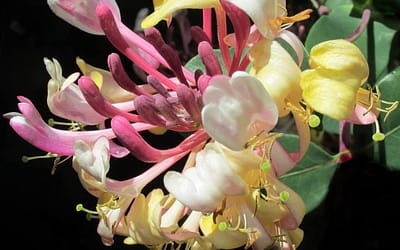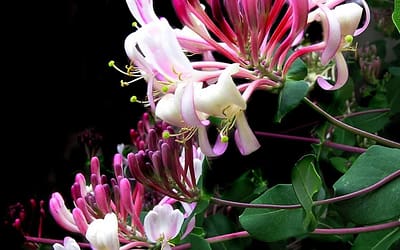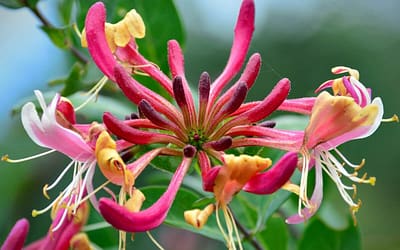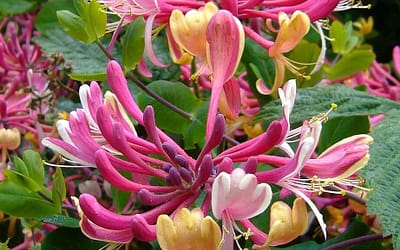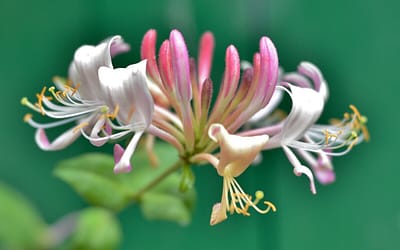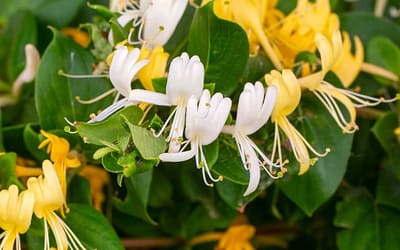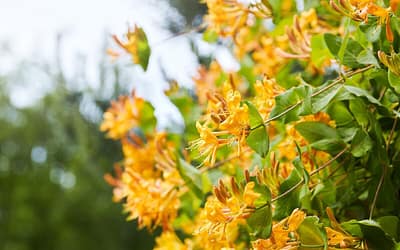Agapanthus africanus Twister – A Stunning Garden Addition
African Lily

Position
- Prefers full sun for optimal flowering.
Hardiness
- Hardy down to approximately -10°C (14°F); may need winter protection in colder areas.
Soil Type
- Well-drained soil, such as sandy or loamy soil, is preferable.
Soil PH
- Tolerates a range of pH levels, including acid, neutral, and alkaline.
Height
- Typically reaches a height of 60 to 75 cm (24 to 30 inches).
Seasons of Interest
- Flowering Times:
- Blooms from mid to late summer with bi-colour flowers of white and blue.
- Foliage:
- Strap-like green leaves; no significant variegation or notable autumn colour changes.
Agapanthus 'Twister': The Show Stopping Bi-Colour African Lily for Your Garden

Agapanthus ‘Twister’ is a beautiful and versatile perennial that adds a striking focal point to any garden. This variety of Agapanthus, also known as the African Lily, is particularly notable for its unique bi-colour flowers. The combination of pure white and vibrant blue blooms creates a dramatic contrast that can brighten any border, pot, or pathway. Agapanthus’ Twister’ should be on your list if you’re looking for an eye-catching plant with low-maintenance requirements. Let’s explore the key aspects of growing and caring for this stunning plant.
Key Features of Agapanthus 'Twister'
Agapanthus ‘Twister’ produces beautiful trumpet-shaped flowers that are white at the base and fade to deep blue-violet at the tips. This bi-colour effect is especially striking when grown in groups or contrasted with solid-colour flowers. The flowers bloom on tall, sturdy stems, reaching heights of up to 80 cm (31 inches), making them an ideal plant for adding height to borders and garden beds.
Agapanthus ‘Twister’ leaves are lush and strap-like, forming a dense clump of foliage that provides year-round interest. Although the flowers are the main attraction, the evergreen or semi-evergreen leaves (depending on the climate) keep your garden looking tidy, even outside the flowering season.
Agapanthus ‘Twister’ blooms from mid to late summer, offering months of colourful display when other plants may start to fade. The flowers also attract bees and other pollinators, making it an excellent choice for wildlife-friendly gardens.
Growing Conditions for Agapanthus 'Twister'
Providing the right growing conditions is essential to getting the most out of Agapanthus ‘Twister’. This plant thrives in full sun, so choose a location where it can soak up plenty of light. In terms of soil, it prefers well-drained, fertile soil with plenty of organic matter. While it can tolerate a range of soil types, from sandy to clay, good drainage is essential to prevent waterlogging, which can lead to root rot.
Agapanthus ‘Twister’ is relatively drought-tolerant once established, but keeping the soil moist during the growing season is essential, especially during dry spells. Regular watering will help ensure the plant produces plenty of healthy blooms. However, be careful not to overwater, leading to soggy soil and poor plant health.
Temperature Tolerance
Agapanthus ‘Twister’ is relatively hardy for an Agapanthus species, tolerating temperatures to about -10°C (14°F). In areas where winters are frigid, it’s a good idea to provide some protection, such as mulching the base of the plant to protect the roots from frost. In milder climates, ‘Twister’ can be grown as an evergreen perennial, but in colder regions, it may die back to the ground and regrow in the spring.
If you live in an area where temperatures regularly drop below -10°C (14°F), consider growing Agapanthus ‘Twister’ in pots so you can move them to a sheltered location or greenhouse during the winter months. Containers should be at least 30 cm (12 inches) in diameter and filled with a well-draining potting mix. Be sure to water sparingly during the winter months to prevent root rot.
Planting and Propagation
Agapanthus ‘Twister’ can be planted in spring or autumn, depending on your climate. For best results, plant bulbs or young plants in groups of three to five, allowing about 30 cm (12 inches) of space between each plant. This will enable them to spread and create a more dramatic display when they bloom.
To propagate Agapanthus ‘Twister’, you can divide the plant in early spring or after it has finished flowering in the autumn. Dig up the clump and carefully separate the roots, ensuring each division has several leaves and roots attached. Replant the divisions at the same depth as the original plant and water well.
Caring for Agapanthus 'Twister'
Agapanthus ‘Twister’ is generally low-maintenance, making it an excellent choice for experienced and beginner gardeners. The most critical tasks are ensuring the plant gets enough water during the growing season and cutting back the flower stems after blooming to encourage further flowering and prevent seed formation. Deadheading also keeps the plant looking tidy and promotes the development of more blooms.
Although ‘Twister’ is relatively drought-tolerant, feeding the plant with a balanced fertiliser in the spring is still a good idea to support healthy growth and abundant flowering. A slow-release fertiliser or a liquid feed every few weeks will provide the necessary nutrients.
In the autumn, you can cut back any dead or damaged foliage to keep the plant neat in winter. If you’re growing Agapanthus ‘Twister’ in pots, bringing the plants under cover or providing extra protection from frost during cold weather is essential. Wrapping the pots with bubble wrap or horticultural fleece can help insulate the roots from freezing temperatures.
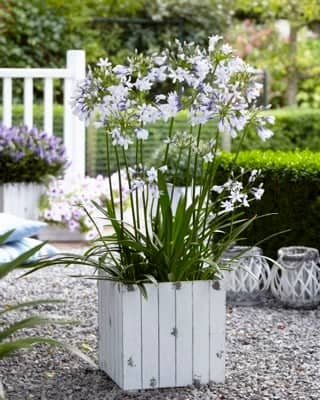
Pests and Diseases
Agapanthus ‘Twister’ is generally resistant to pests and diseases, but like most plants, it can be susceptible to a few common issues. Slugs and snails may occasionally nibble on the leaves, mainly when the plants are young. You can use slug pellets or create barriers around the plants with crushed eggshells or copper tape to deter these pests.
Overwatering can lead to root rot problems, so it’s important to maintain good drainage and avoid waterlogged conditions. If you notice the leaves turning yellow or the plant wilting, this could be a sign of poor drainage or overwatering. In these cases, check the soil and adjust your watering routine accordingly.
Popular Uses in the Garden
Agapanthus ‘Twister’ is highly versatile and works well in various garden settings. Its tall flower stems make it a perfect choice for the back of a border, where the blooms can rise above shorter plants. The striking bi-colour flowers look stunning when paired with complementary colours like deep purples, whites, or silvers. Consider planting Agapanthus ‘Twister’ alongside lavender, salvia, or ornamental grasses for a sophisticated, textural display.
If you’re growing Agapanthus ‘Twister’ in containers, they can be placed on patios, terraces, or near entrances to create a welcoming and stylish feature. The tall stems and dramatic blooms can also be used as cut flowers, bringing the beauty of your garden indoors.
Conclusion
Agapanthus ‘Twister’ is a beautiful and reliable addition to any garden. Its unique bi-colour flowers and its low-maintenance nature make it a favourite among gardeners. Whether you plant it in a border, container, or mixed planting scheme, Agapanthus ‘Twister’ will provide months of summer colour and interest. With the proper care and attention, you’ll enjoy these stunning blooms year after year.
If you’re interested in learning more about Agapanthus ‘Twister,’ the RHS has a lovely article that you can read here.
For more information on Herbaceous Perennials, please click here.
Frequently Asked Questions
Q: What makes ‘Twister’ different from other Agapanthus?
A: ‘Twister’ stands out with its striking bi-coloured flowers. Each bloom has a pure white base that fades into vibrant blue-purple at the tips, creating a dramatic two-tone effect. With dozens of flowers per head, it makes a stunning display in any garden.
Q: How tall does ‘Twister’ grow?
A: This compact variety reaches 60–75cm (24–30 inches) in height. Its tall flower stems rise elegantly above the strap-like foliage, ideal for borders and container planting.
Q: When does it flower?
A: ‘Twister’ blooms from mid-summer to early autumn, typically from July to September. Each flower head lasts several weeks, ensuring a long-lasting burst of colour in your garden.
Q: What growing conditions does it need?
A: ‘Twister’ thrives in full sun and well-drained soil. While it adapts to most soil types, it performs best in rich, moisture-retentive soil that doesn’t become waterlogged.
Q: How hardy is Agapanthus ‘Twister’?
A: This variety can withstand temperatures as low as -10°C (14°F). In colder regions, protect the crown with mulch in winter or grow it in a container that can be moved to a sheltered spot.
Q: Can I grow it in containers?
A: Yes, ‘Twister’ is perfect for container growing. Use a pot at least 30cm (12 inches) deep with suitable drainage holes. Slightly restricted roots often encourage better flowering.
Q: What maintenance does it need?
A: Regular deadheading keeps the plant tidy and may encourage further flowering. Remove yellowing leaves and divide congested clumps every 4–5 years in spring to maintain vigour and create new plants.
Q: How often should I water and feed?
A: Water regularly during the growing season, especially if grown in containers. Apply a balanced feed in spring and switch to a high-potash feed when flower buds form to boost blooming.
Q: Does it attract wildlife?
A: Yes! The nectar-rich flowers attract bees, butterflies, and other pollinators, while the architectural seed heads provide winter interest and food for birds.
Q: What problems should I watch for?
A: Slugs and snails can damage new shoots and flower stems, particularly in spring. Root rot may occur in poorly drained soil, so ensure good drainage to keep the plant healthy.
Q: Where can I buy Agapanthus ‘Twister’?
A: Agapanthus ‘Twister’ is widely available at garden centres and online retailers. You can find it from specialist nurseries, plant websites, and major gardening stores.
Related Articles
Lonicera periclymenum Rhubarb and Custard
Honeysuckle Full sun to partial shade Any aspect - north, south, east, or west-facing Sheltered or exposed positions Ideal against walls, fences, or through trees Tolerates temperatures down to -20°C (-4°F) Fully hardy throughout UK Moist but well-drained soil Adapts...
Lonicera Belgica – Early Dutch Honeysuckle
Early Dutch Honeysuckle Partial shade to full sun North, south, east, or west-facing aspects Sheltered or exposed sites suitable Best against walls, fences, or climbing through trees Tolerates temperatures down to -20°C (-4°F) Fully hardy throughout UK Moist but...
Lonicera x heckrottii American Beauty
Honeysuckle Full sun to partial shade East, west, or south-facing aspects Sheltered or exposed locations suitable Fully hardy in UK climate Tolerates temperatures down to -15°C (5°F) Thrives in moist but well-drained soil Adaptable to clay and loam soils Suits acid,...
Lonicera Serotina – Late Dutch Honeysuckle
Late Dutch Honeysuckle Best in partial shade, though tolerates full sun Suitable for east, west, south, or north-facing aspects Can be grown in exposed or sheltered locations Fully hardy in UK climate Tolerates temperatures down to -20°C (-4°F) Adaptable to chalk,...
Lonicera periclymenum Strawberries and Cream
Honeysuckle Full sun to partial shade Sheltered from strong winds North, east, or west-facing walls suitable Fully hardy in UK climate Tolerates temperatures down to -15°C (5°F) Moist but well-drained Rich in organic matter Fertile loam ideal Adaptable to all soil...
Lonicera japonica Halls Prolific
Japanese Honeysuckle Full sun or partial shade South or west-facing aspect ideal Sheltered from strong winds Can grow in north-facing positions but may flower less Hardy down to -15°C (5°F) Semi-evergreen in mild winters, deciduous in harsh winters Moist but...
Lonicera x tellmanniana
Tellmann's Honeysuckle Prefers full sun or partial shade Ideal for a south-west facing position Should be sheltered from strong winds Roots enjoy cool conditions while the stems reach for sunlight Hardy down to -15°C to -10°C (5°F to 14°F) Thrives in moist but...
Lonicera periclymenum
Common Honeysuckle Prefers full sun to partial shade A sheltered spot is ideal to protect from harsh winds Can survive temperatures down to -15°C (5°F) Thrives in well-drained soil Can adapt to a range of soil types, including clay, loamy, and sandy soils Prefers...
Hedera helix Glacier
Glacier Ivy North, east, or west-facing walls Partial to full shade Sheltered from strong winds Can tolerate full sun in cooler areas Down to -15°C (5°F) Well-drained soil Medium moisture retention Rich in organic matter Clay, loam, or sandy soils all suitable Neutral...

